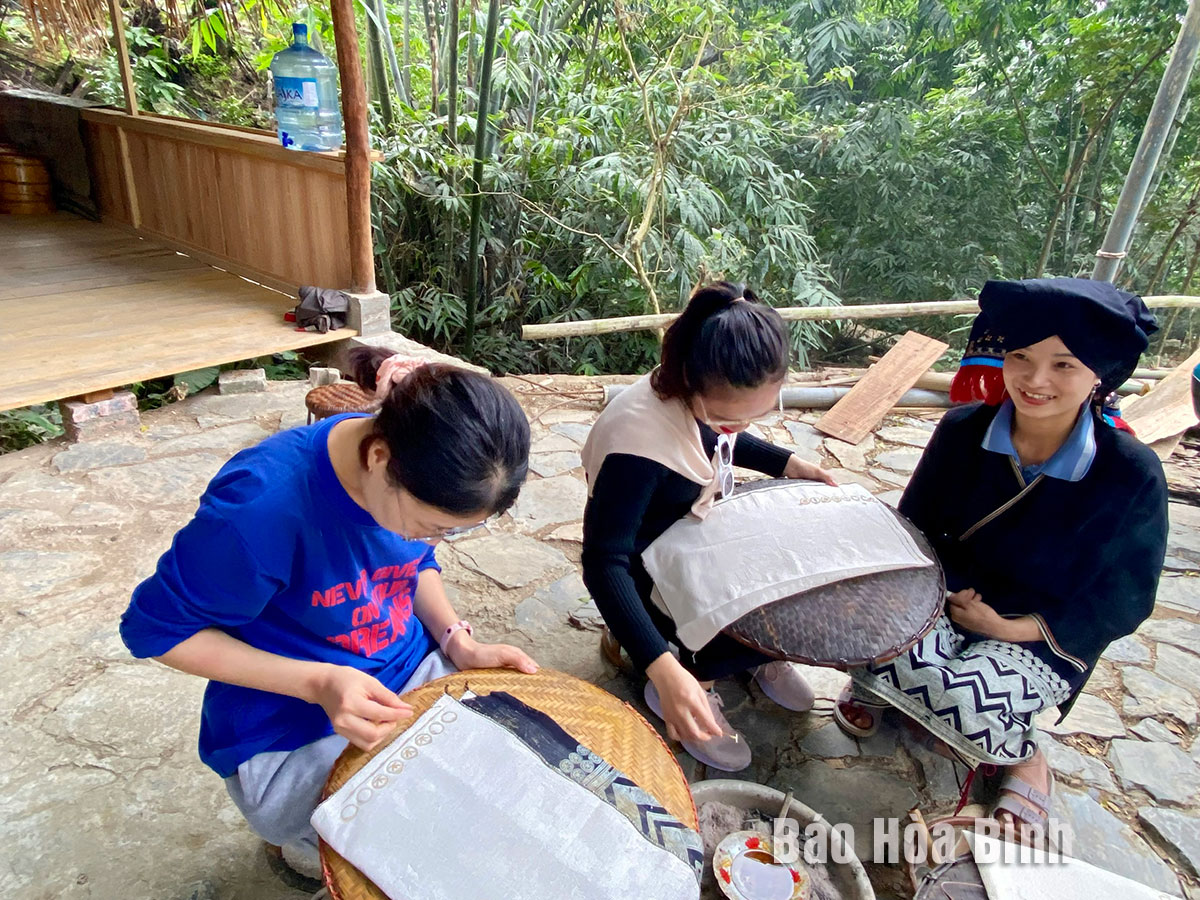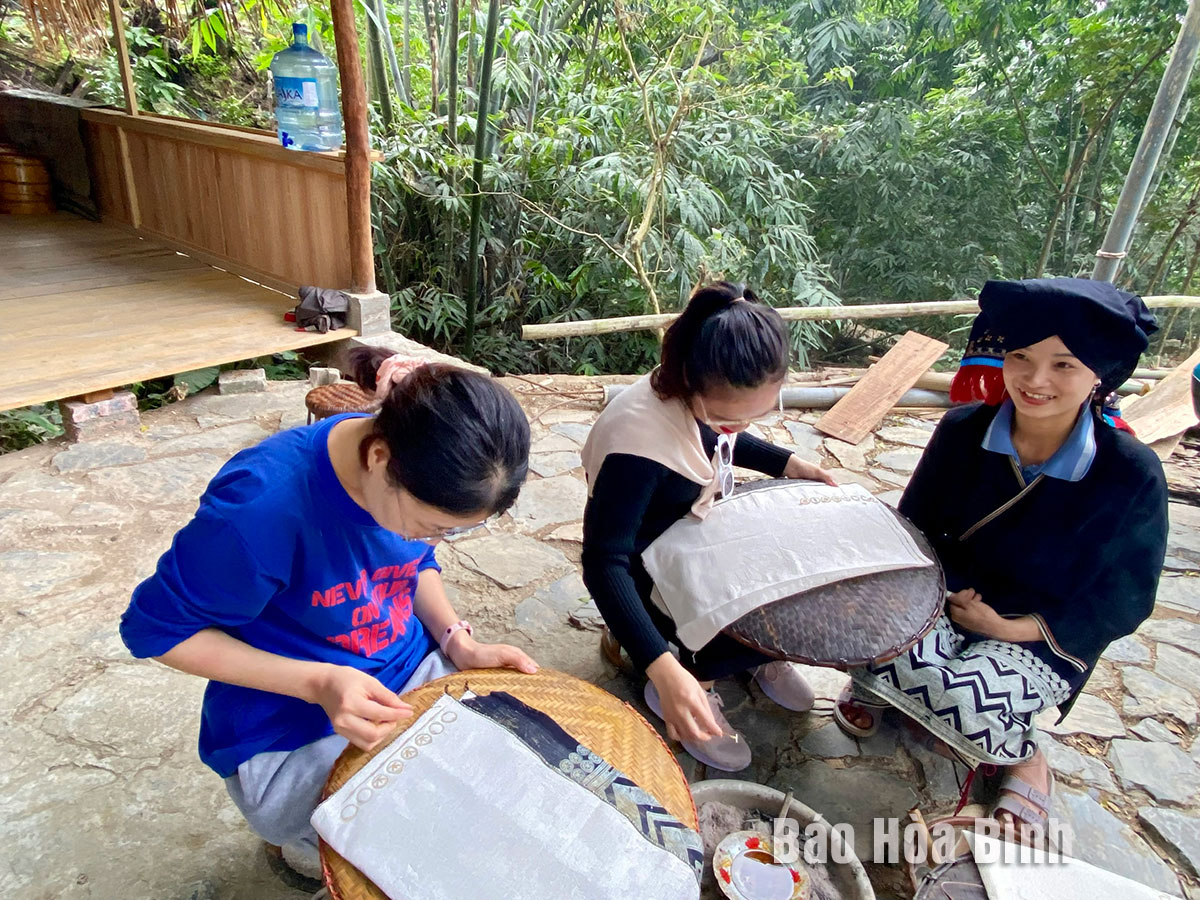
About 100km from Hanoi and located besides Bieu Mountain, the over-500-year Sung village in Cao Son commune, Da Bac district, is home to a Dao Tien ethnic community. With support from the Action on Poverty (AOP) organisation, the Da Bac Community-based Tourism JSC has carried out the community-based tourism model in the village. The village of Dao Tien ethnic people officially opened to tourists in 2017.
Tourists learn and try the craft of beeswax drawing in Sung village of Cao Son commune, Da Bac district.
Community-based tourism activities in Sung village have attracted a large number of travellers, especially foreigners, thanks to the untouched natural beauty and unique culture. Aside from some typical tourism and service products like going sightseeing, exploring Sung Cave, and picking shan tuyet tea buds, community-based tourism here also offers products linked with traditional crafts, thus meeting travellers’ increasingly diverse exploring and experiencing demand.
Ly Van Quy, head of the medicinal material group in Sung village, said that local residents had previously depended on the diverse source of materials in nature to create remedies used in their families. Benefiting from the AOP’s sustainable community-based tourism development project, a traditional medicine group was established in the village and received training as well as financial aid to build workshops, design packages, and develop new products to sustainably tap into local resources and improve local medicinal products’ competitiveness.
The group has launched four products, namely sweet jiaogulan (Gynostemma pentaphyllum) tea, bath herbs, herbal mosquito repellent spray, and red ginger massage solution, he noted.
Meanwhile, the production of "do” paper used to be eroded seriously, and there was only one household involved in this craft. However, the village is home to a large area of materials for making "do” paper, which is why the sustainable community-based tourism development project decided to support Dao Tien ethnic people here to uphold the traditional craft. As a result, a cooperative group for "do” paper production was set up in Sung to develop related products
In addition, the crafts of dyeing fabrics indigo, drawing beeswax on clothes, and making brocades have also been revitalised. The brocade making group now gathers 11 women who were trained in using sewing machines, Japan’s Shibori dyeing technique, and designing to create more diverse and fashionable products to meet tourists’ taste.
Ly Sao Mai, a coordinator at the Da Bac Community-based Tourism JSC in Sung village, said that traditional crafts are being preserved and brought into play to create more diverse and attractive tourism products. At the same time, jobs have been diversified to attract more workers, thus raising income and ensuring stable livelihoods for locals.
She went on to say that more than 80% of the local households are engaging in accommodation, eating, tour guide, and musical performance services, along with brocade, medicinal material, and "do” paper production. The groups of traditional crafts, especially "do” paper and brocade making, now frequently serve visitors coming to explore and experience.
Nguyen Hai Yen, a tourist from Hanoi, said she was very impressed with an ethnic minority village located besides Hoa Binh Lake where the long-standing lifestyle, large forest, and fresh air are still maintained. During the two-day stay in this community-based tourism village, she gained many memorable experiences and learned much more about traditional crafts – one of the unique cultural identities of Dao people. She tried and bought many herbal products such as the massage solution and mosquito repellent as gifts for relatives as she found they are safe, convenient, and useful. A number of such products as handbags, purses, tablecloth, and paintings are also relatively beautiful and have reasonable prices, suitable for tourists to buy as souvenirs.
With an increasingly vibrant and widespread emulation movement aimed at building cultured residential areas and cultured families, Yen Thuy District has been making steady progress toward improving both the material and spiritual well-being of its people, while fostering a civilized, prosperous, beautiful, and progressive community.
Once lacking recreational spaces and community facilities, Residential Group 2 in Quynh Lam Ward (Hoa Binh City) has recently received attention for the construction of a new, spacious, and fully equipped cultural house. The project followed the model of state support combined with public contributions in both labor and funding.
The "All people unite to build cultural life" movement, which has been effectively integrated with Kim Boi district’s socio-economic development goals, is fostering a lively spirit of emulation across local residential areas, hamlets, villages, public agencies, and enterprises. In addition, through the initiative, traditional cultural values are being preserved and promoted, while community solidarity and mutual support in poverty reduction and economic development are being strengthened.
A working delegation of the Hoa Binh provincial People’s Committee led by its Permanent Vice Chairman Nguyen Van Toan on June 11 inspected the progress of a project to build the Mo Muong Cultural Heritage Conservation Space linked to tourism services in Hop Phong commune, Cao Phong district.
Born and growing in the heroic land of Muong Dong, Dinh Thi Kieu Dung, a resident in Bo town of Kim Boi district, in her childhood was nurtured by the sweet lullabies of her grandmother and mother. These melodies deeply imprinted on her soul, becoming an inseparable part of her love for her ethnic group's culture. For over 20 years, this love for her hometown has driven Dung to research, collect, and pass down the cultural values of the Muong people to future generations.
In the final days of May, the Ethnic Art Troupe of Hoa Binh Province organized performances to serve the people in remote, mountainous, and particularly disadvantaged areas within the province. These were not just ordinary artistic shows, but they were the meaningful journeys aimed at spreading cultural values, enhancing the spiritual life of the people and contributing to the preservation of ethnic minority cultural identities.



